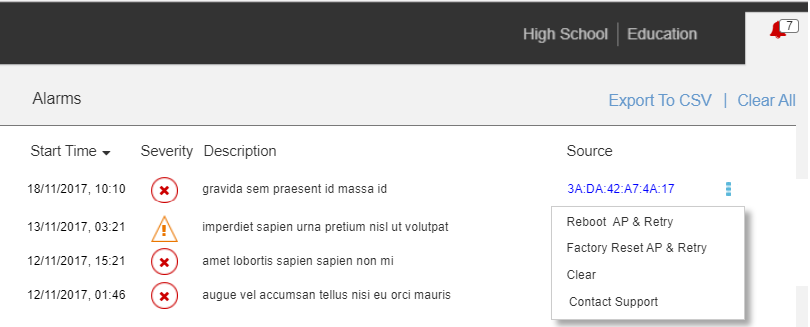Getting to Know the Dashboard
The Dashboard is the first page that appears after you log in to the Ruckus LTE AP Management portal. The Dashboard displays both LTE and WiFi alarms, venues, APs, and users.
The Wi-Fi clients widgets (circle marks) appears on the Dashboard only when there is a Wi-Fi configuration and/or a Wi-Fi license purchased.
| Number | Box Name | Description |
|---|---|---|
| 1 | Alarms |
Displays the number of uncleared alarms that are generated on your Ruckus LTE networks. When no alarms are generated, the message No Active Alarms appears when you click Alarms. To view details of the uncleared alarms Expand. The following information pertaining to active alarms is displayed.
For the alarms pertaining to failed tasks display action overflow menu (three vertical dots) icon.

Alternatively, click the bell icon on the top-right corner to view alarm details. A resizable pop-up window appears displaying the alarm details. Click the bottom-left corner of the Alarms window to resize it. |
| 2 | Venues | Displays the number of venues that have been configured in your
LTE AP Management account.
|
| 3 | APs | Displays the number of LTE and Wi-Fi APs in separate widgets (circle marks) that have been added to the
LTE AP Management account. If there are no Wi-Fi and LTE APs, the values are displayed as "0", circled in gray. If there are APs, the respective values are circled in green.
|
| 4 | Clients | Displays the number of LTE and Wi-Fi clients that are currently connected to managed APs, inside a widget (circle mark). If there are no Wi-Fi and LTE clients, the value is displayed as "0", circled in gray. If there are users, the respective values are circled in green.
Clicking the Clients link displays the Users page with LTE as the default tab and the LTE user details are displayed. If one of the previous conditions exist, the WiFi widget is displayed along side the LTE widget. To view the Users page with the WiFi tab as the default, click WiFi. In the grid that displays the client details, primary sorting is based on the number of clients in a venue and secondary sorting is based on the number clients in an AP. The venue with the highest number of clients appears in the top most row and proceeds in descending order. Clicking the row displays the relevant venue or AP. Note: Unlike WiFi, the LTE tab displays only the number of currently connected clients, per venue.
|
| 5 | Essential shortcuts | Displays shortcuts for the following basic tasks:
|
| 6 | Map | Displays venue location markers within the Google map. |
Color-coding of Numbers for Venues, APs, and Clients
The segmented color lines around the numbers of venues, APs and clients indicate the statuses of the venues and APs.
- Green: Operating normally
- Red: Requires attention
- Grey: Remains in setup mode

